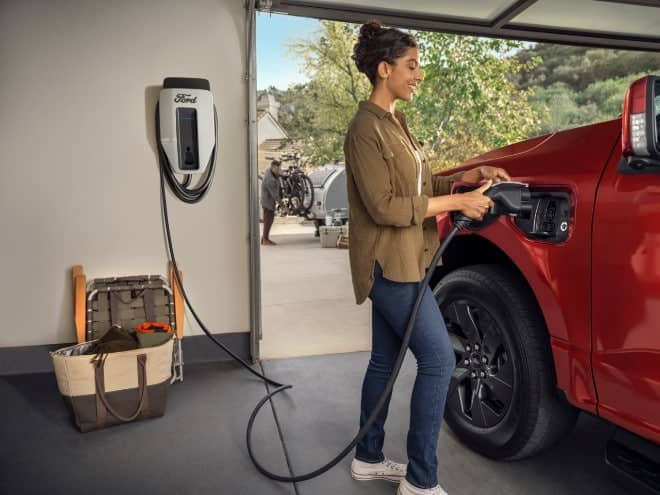St. Pete lab tests EV batteries as grid resource
Researchers at Duke Energy’s St. Petersburg lab are exploring if electrical vehicles (EVs) can power Florida homes during outages and help support the state’s electrical grid.
On Aug. 16, the company announced a research and development pilot in Florida that will test and evaluate the viability of the new Ford F – 150 Lightning electric truck’s high-capacity batteries. The two-way charging capability of the innovative batteries could potentially transform the energy system.
Vehicle-to-grid integration will push and pull energy between connected trucks in a bidirectional flow using the Ford Charge Station Pro and Intelligent Backup Power Home Integration System. Staff at Duke’s Energy Wise Lab, a high-tech facility located in a nondescript building off 13th Avenue S in St. Petersburg, will conduct the ground-breaking testing.
“We always look for opportunities to maximize the value of new technology out there,” said Lon Huber, senior VP of customer solutions. “And we said, ‘wow, this is going to be a very large battery that, for the most part, is going to sit there idle.'”

Lon Huber, senior VP of customer solutions for Duke.
The plan, explained Huber, is to see if using the batteries at critical times benefits everyone on the electrical grid. He said Ford’s leadership was very receptive to the pilot program, providing vehicles, hardware and software not yet available to the public.
Researchers, said Huber, will take a hybrid approach to the testing by alternating between pushing extra energy to the grid during periods of high consumption and pulling power from it during off-peak hours. The St. Petersburg lab allows them to simulate three home environments simultaneously and gauge the effects on the truck’s batteries over time.
After the initial lab testing phase, Duke will assess the battery capabilities in Florida homes with other customer-owned energy resources, such as solar panels. The goal, said Huber, is to see how the two systems would integrate and if they could power an entire home during extended outages.
As people increasingly opt for electric vehicles, Huber noted the importance of ensuring they recharge at optimal times and avoid system peaks that could drive up prices and add stress to the grid.
With most families owning at least two cars, he added that entire neighborhoods charging in an orchestrated way could significantly minimize costs.
“On the grid side, we want to make sure that we actually dispatch the battery capability to maximize benefits when the grid needs it the most,” said Huber. “All in a coordinated way.
In light of that “significant pull and push,” researchers will ascertain if homes with solar systems can efficiently charge the vehicles and reduce grid consumption. Duke will also identify any potential conflicts between the two energy sources.
Huber believes testing will show more synergies than clashes, and the testing will focus on whether the electric truck can effectively back up a solar-powered home.
Ford claims its Intelligent Backup Power System, introduced with the Lightning, allows the truck to power a home for up three days. Huber said someone utilizing the technology could power a refrigerator for about two weeks, but running things like air conditioning units drastically decrease that time frame.
The hardware needed to power a home using the Lightning’s battery is now available to the public. However, consumers will have to wait until next year for the required vehicle software updates. Duke, said Huber, chose the Lightning for its pilot program as it is the first EV to market with a battery large enough to provide vehicle-to-home and vehicle-to-grid capabilities.

Huber said the Lightning is the first EV to market with a battery large enough to provide vehicle-to-home and vehicle-to-grid capabilities.
While charging an EV battery will raise home energy costs, Huber said the money saved on gasoline purchases would dwarf the increase. He added that Duke also provides special rates for charging the vehicles.
If the pilot testing is successful, with researchers quantifying the benefits that EVs can provide to the grid, Huber said Duke would then file the paperwork needed to create a large-scale program. He called the latest research – emanating from an innovative St. Petersburg facility that once housed a call center – a natural evolution in the company’s utilization of the latest technologies to meet customer needs.
“While they’re not using their truck, it is literally making money for them while it’s sitting in the garage,” said Huber. “What a great way to partner with our customers to create value for everybody.”







